Abstract
In this study, inquiry was used as a sociological method, and, as an investigation tool, we used a questionnaire based on closed and open questions about aspects of the environmental state, the respondents’ perceptions and attitudes, the respondents being students who work in the area of Târgovişte municipality. This study also aims to assess the interest in the relation between urban and natural environment. It was found that the natural environment and man suffer increasingly more because of the absorption of resources by the society but also because of the inclusion of foreign components in the normal composition of the environment resulting from human activities or due to the fragmentation of the natural ecological system by continued economic growth and fragmented society, especially of the private sector. In addition to the questionnaire mentioned above, a literature review was realized, consulting bibliographical sources and archival directories of communicated data and information. Following the documentation and the questionnaire, we have conducted a series of graphs illustrating the involvement of families, schools and other institutions in local and national programs related to the environmental education perception, particularly in point of selective waste collection.
Keywords: Environmentwasteeducation
Introduction
The role of the educational institutions, of the teachers as trainers shaping the public opinion concerning the environmental education and the involvement of the pupils and of the students in environmental problems has been highlighted by the application of a questionnaire. Out of the answers given to the questions included in the questionnaire, one can evaluate the teachers’ involvement and perception regarding the environment where they live and work. At the same time, the answers to the respective items highlight some environmental dysfunctionalities.
Environmental education relies on awareness (it supposes understanding and sensitivity to the environmental problems), knowledge (understanding the mechanism of balanced environmental functioning), attitude (desire to participate to maintain the environmental balance), habits (acquiring the necessary abilities to identify and investigate the problems the environment is faced with and contribute to solving them), participation (putting into practice the knowledge and skills acquired, in order to realize positive and well-conceived actions that will lead to solving the environmental problems (Fig. 1).

All these elements are closely related and only by going through a number of five objectives can an efficient environmental education and a sustainable development be obtained.
In a society aspiring to sustainable education, by living in consensus with the environment, it is necessary to maintain the environmental balance (Fig. 2).
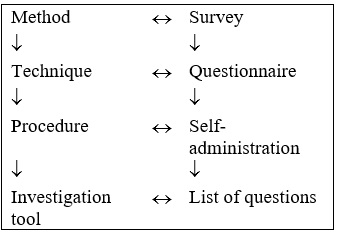
Environmental education is a process meant to attract different social categories who should be aware and preoccupied by the environmental problems but should also have the knowledge, attitude, skills, motivation and capacity to interact to find solutions or to prevent environmental situations (Dincă, 2007). The basis of an efficient teaching approach is learning by direct interaction with the natural environment. Ecological conscience is at the basis of the ecological conduct, of the ecological behavior (Pehoiu, Muică & Sencovici, 2006).
Thus, educational institutions have a very important role in making the pupils receptive to what is shown to them and what is said to them regarding the environment. The mission of the educational institutions is to offer, gradually and in harmony with the age particularities, scientific knowledge able to motivate the eco-civic conducts and norms, to create and organize educative activities and actions regarding the environment. The ecological conduct is the way the ecological conscience (knowledge of the sense of each species in life on Earth) shaped by education determines ethical actions and attitudes to the life surrounding us.
Problem Statement
In the present analysis we applied a questionnaire as a tool for investigating the perception of the role of educational institutions in environmental education..
Research Questions
We tried, by applying questions structured according to well-defined principles, to awaken the interest and get the subject to answer as sincerely and clearly as possible to the respective items (Chelcea, Mǎrginean & Cauc, 1998).
Purpose of the Study
A hierarchy of the terms would include the following examples: survey is a method; the questionnaire used represents a technique; the self-administration of the questionnaire is a procedure; the list of questions in the questionnaire represents an investigation tool (Fig. 3).
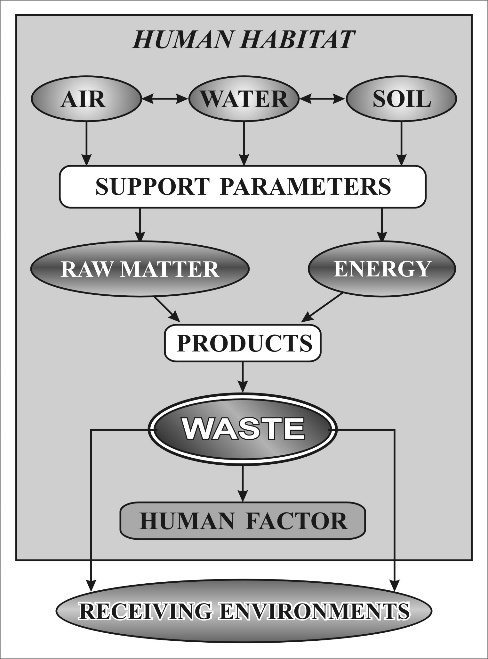
The collection of the information was realized after the subjects were motivated by the explanations given and after mentioning the aim pursued. The information obtained was processed and based on this information, different representative graphs were obtained.
Research Methods
The questionnaire was applied on a sample of
Findings
Out of the analysis of the graph for item 5 it results that most of the answers belong to the category bad and satisfactory quality of the environmental components. The component appreciated as very affected refers to the vegetation, because during the last years, the oxygenated area increased, but only in the central area and in the area of the intersections by the realization of green roundabouts in the area of the municipality. A very low number of respondents situated this vegetal component of the environment in the category “very good”, a fact demonstrating that the young are aware of the very important role of the green, oxygenated areas (Fig. 4).
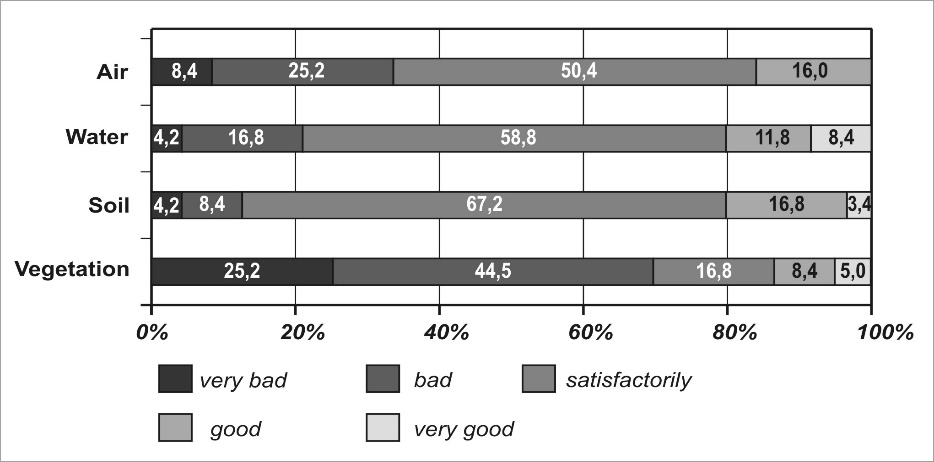
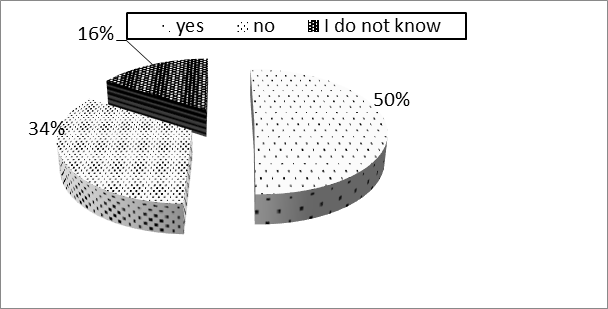
The subjects, when they were asked if the wastes collection was done in good conditions answered in proportion of 50% affirmatively but one can note a quite high percentage, 40% of the interviewees, who answered negatively. Impressive is the fact that 19% of the interviewees do not know how domestic wastes are collected (Fig. 5).
After the application of item 7 it has been noticed that the majority of the respondents answered that the wastes are not collected selectively in their families, which denotes that the percentage of the subjects who receive in the family an adequate education, regarding the selective wastes collection
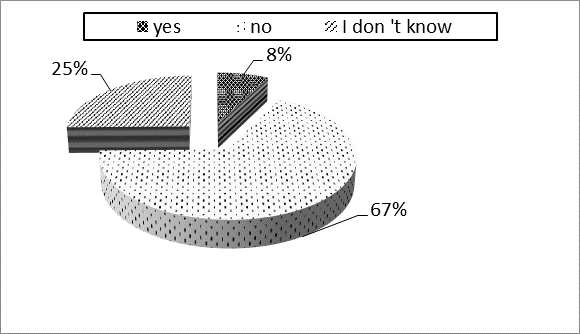
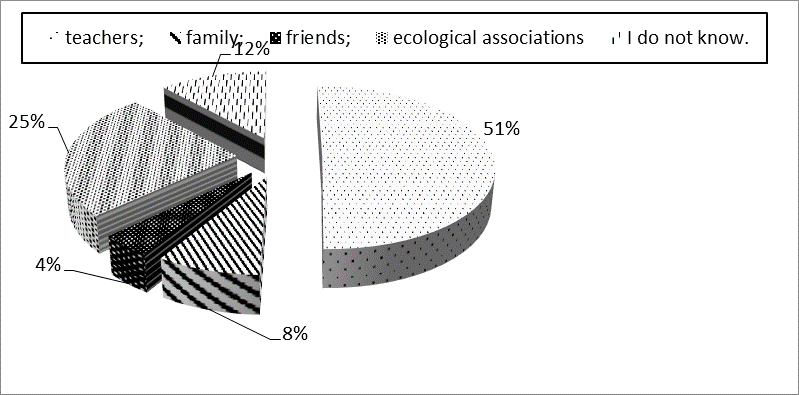
Most of the respondents answered that the habit of selective collection of the domestic wastes was taken over from school /high school, completed and supported by different activities by the faculty (Fig. 7). From this item, it has also been noticed that, in a significant percentage, the subjects appreciated that ecological Associations had an important role in their awareness regarding the selective wastes collection.
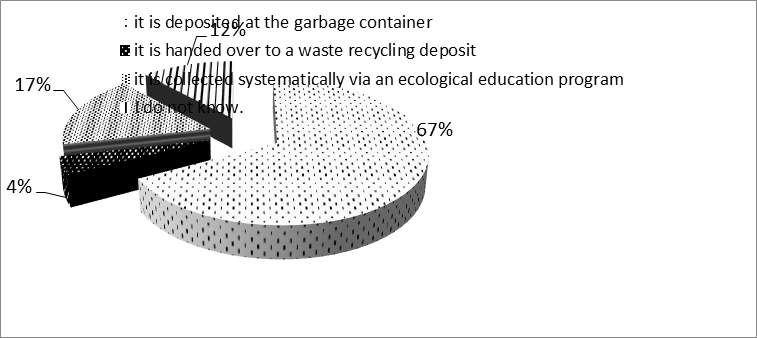
For this item, it has been answered in a percentage of 67% that recyclable wastes are deposited in the waste container (Fig. 8). A number of 20 respondents answered that wastes
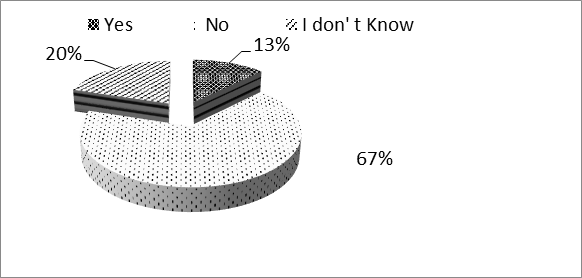
For item 10, which refers to the existence of special places for depositing large wastes (for example from repairs sites, apartment modernization, old domestic appliances etc.)? the subjects answered in a proportion of 67% that this does not exist. Again, a high percentage (20%) has been noticed of those who do not know the neighborhood, do not know if such special depositing places exist (Fig. 9).
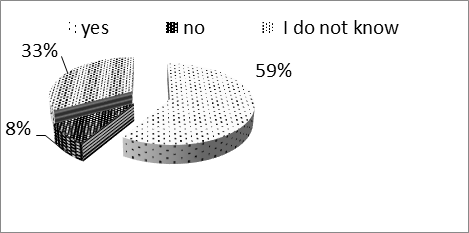
For item 11 it is noticed that 33% of the interviewees know no aspects related to the environmental quality outside their neighborhood (Fig. 10).
The research undertaken highlights, by the answers received to the 12 questions of the questionnaire addressed to the students, their opinion on the environmental problems in the area where they live. The subjects largely admit the existence of environmental dysfunctionalities in their neighborhood. We analyzed and interpreted the perception level, the result highlighting the discomfort they feel and the need for information.
Conclusion
After the realization of this study, it has been noticed that the number of the respondents who appropriated the habit of selective wastes collection in the family is low, only a percentage of 8% admitted the role of the family in ecological awareness, while 25% acknowledged the important role of the ecological Associations. A high percentage (51%) went to the special role of the education institutions.
The family took over from the children the habit of a correct selective wastes collection and, consequently, one can affirm that the educational institutions have an important role in environmental education, the teachers being the ones shaping in the pupils, in the students, convictions, habits and attitudes reflected in an adequate behavior towards the environment.
Another aspect understood following this study refers to the dysfunctionalities related to the residual wastes resulted from all the renewal, home modernization activities.

What has been noticed is an active involvement of the educational units and of the other institutions in local and national environmental education programs, especially related to selective wastes collection.
Maintaining a balance between natural development and offering better living conditions for the population in the long run supposes: reducing the quantities of wastes, adequate hygiene for the depositing places, increasing the green (oxygenated) areas, increasing the number of projects meant for environmental protection in the educational units.
The interdependence between economic-social development and environmental development is prominent in the urban area, concentrating most of the environmental dysfunctionalities.
A human habitat relies on abiotic, biotic and anthropic factors, their interaction yielding products and wastes assimilated by the receiving environments of the urban ecosystems but also by its neighboring areas (Fig. 12).

In order to successfully realize the environmental education, it is essential to effectively combine the forms of “alternative education” with the forms of institutionalized education. In environmental education, important and relevant are the power of the example and of the word, each person must have the possibility to manifest his personal attitude, the responsibility to the environment he lives in.
The participation of the education units in the activities related to knowing, understanding some environmental acts and phenomena, identifying and solving certain environmental pollution and degradation problems, results in the formation of certain convictions and habits related to the environmental defense, conservation and balanced development.
The educational units, by their destination and role, assure the adequate environment for the development of a complex training: both instructive and educative.
The pupils, the students have a very important role in the society, in the geographic environment, as they are the future of the planet and at the same time those who will make a change, trying to create a society more involved in environmental education.

The problems that the present environment is facing are serious and must be approached by the whole community, and education in the educational institutions is a viable solution.
The involvement of the education institutions in the promotion of the environmental problems is the chance of developing a balanced environmental conscience.
The most important role in modeling the children’s and the pupils’ consciences goes to the teachers. The educators, the primary school teachers and the teachers in general, by the curricula of various subjects, by the optional disciplines and extracurricular activities put the pupils and students into concrete or imaginary situations able to awaken their interest and motivate them to act for the improvement of the environmental quality.
The educative approach is directed towards the adoption of an adequate behavior of environmental protection, essential being the modalities of passage from theoretical information towards concrete action, by individual participation.
Acknowledgments
This article is the exclusive contribution of the authors, without other contributions from institutions or individuals.
References
- Chelcea, S. (1992). Metode şi tehnici de cercetare sociologică [Sociological Research Methods and Techniques]. Suport de curs, Facultatea de Sociologie, Psihologie, Pedagogie, Catedra de Sociologie, Universitatea Bucureşti.
- Chelcea, S., Mǎrginean, I. & Cauc, I. (1998). Cercetarea sociologică. Metode şi tehnici [Sociological Research. Methods and Techniques]. Deva, Romania: Editura Destin.
- Dincă, C. (2007). Educaţia ecologicǎ şi programele CCDG – o provocare pentru şcolile din România [Ecological Education and CCDG Programs – A Challenge for the Schools in Romania]. In Eco-Şcoala – exemple de bunǎ practicǎ [Eco-Schools – Examples of Good Practice]. Rǎdǎuţi, Romania: Editura Septentrion.
- Pehoiu, G., Muică C. & Sencovici, M. (2006). Geografia mediului cu elemente de ecologie [Environmental Geography with Ecological Elements]. Târgovişte, Romania: Editura Transversal.
- Sencovici, M. (2010). Studiul geografic al mediului în Câmpia Înaltă a Târgoviştei [Geographic Study of the Environemnt in the High Plain of Târgoviste]. Târgovişte, Romania: Editura Transversal.
Copyright information

This work is licensed under a Creative Commons Attribution-NonCommercial-NoDerivatives 4.0 International License.
About this article
Publication Date
30 July 2017
Article Doi
eBook ISBN
978-1-80296-026-6
Publisher
Future Academy
Volume
27
Print ISBN (optional)
-
Edition Number
1st Edition
Pages
1-893
Subjects
Teacher training, teaching, teaching skills, teaching techniques,moral purpose of education, social purpose of education, counselling psychology
Cite this article as:
Sencovici, M., & Pehoiu, G. (2017). Environmental Education In School, Family And Community. In A. Sandu, T. Ciulei, & A. Frunza (Eds.), Multidimensional Education and Professional Development: Ethical Values, vol 27. European Proceedings of Social and Behavioural Sciences (pp. 722-730). Future Academy. https://doi.org/10.15405/epsbs.2017.07.03.86

